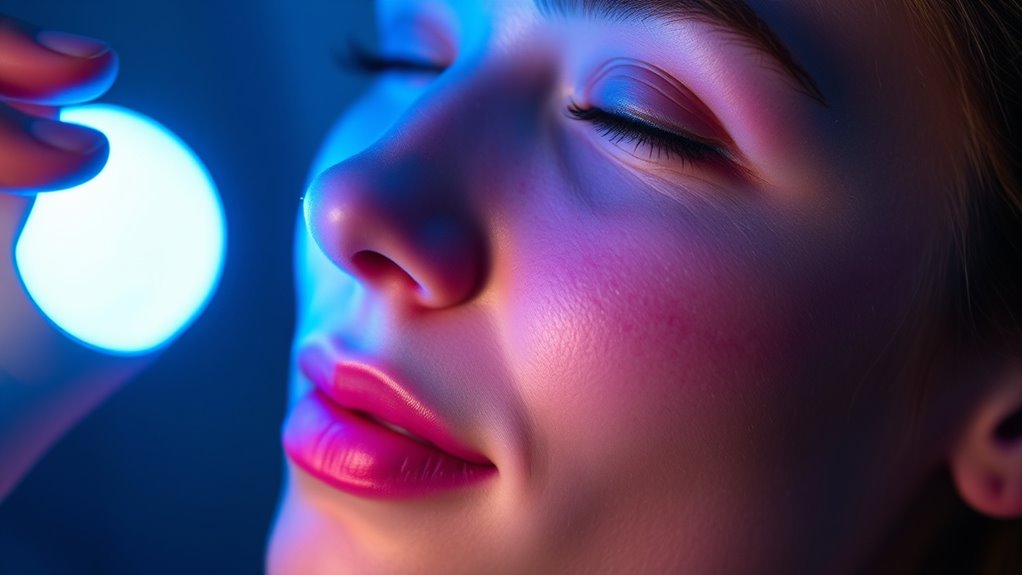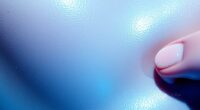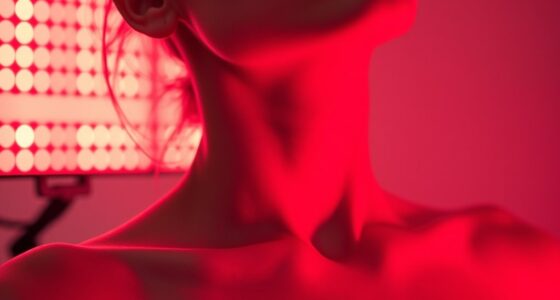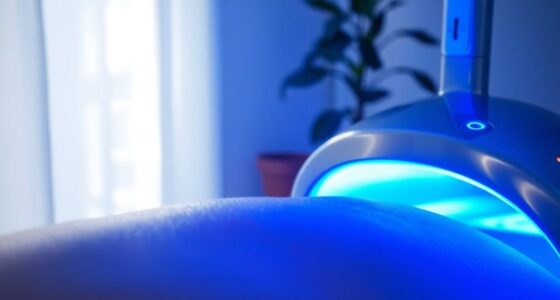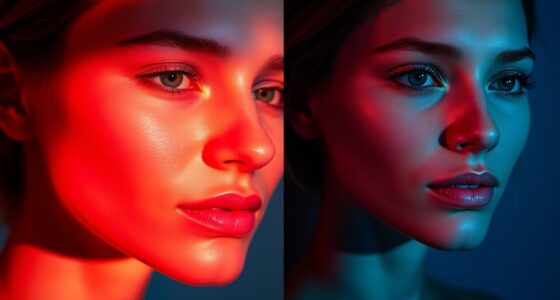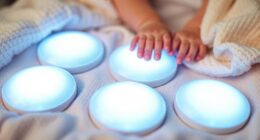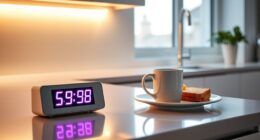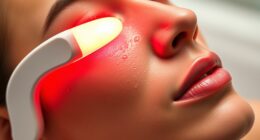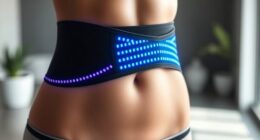Yes, blue light therapy can help after a breakout by reducing inflammation and bacteria that cause acne. It promotes faster healing and prevents future pimples by calming irritated skin and decreasing bacterial presence. This non-invasive, drug-free treatment is suitable for mild to moderate acne and can be easily integrated into your skincare routine. If you’re interested, you’ll discover more about how blue light can support your skin’s recovery and long-term health.
Key Takeaways
- Blue light therapy reduces bacteria and inflammation, helping skin heal faster after a breakout.
- It calms redness and irritation, promoting smoother, healthier skin post-breakout.
- Blue light prevents future breakouts by targeting bacteria that trigger immune responses.
- It is a safe, non-invasive option suitable for sensitive or inflamed skin.
- Regular use supports long-term skin health and maintains clearer skin over time.
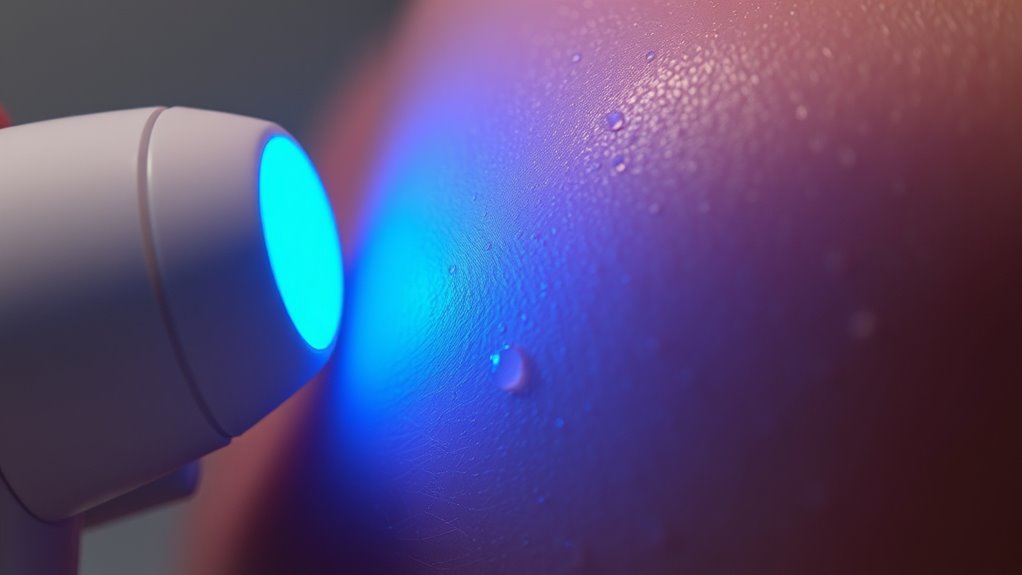
If you’re struggling with stubborn breakouts, blue light therapy might be a game-changer for your skincare routine. This non-invasive treatment targets the root causes of acne by using specific wavelengths of light to kill bacteria responsible for breakouts. When you apply blue light, it penetrates your skin and activates molecules within the bacteria, producing a reaction that destroys them without harming your skin. This process helps reduce inflammation and prevent future pimples from forming. Many people find blue light therapy appealing because it offers a drug-free solution with minimal side effects, making it suitable for sensitive skin types.
Blue light therapy offers a drug-free, gentle way to fight acne and reduce inflammation.
After a breakout, your skin often appears inflamed, red, and irritated. Blue light therapy can help calm this inflammation by reducing the bacteria that trigger the immune response. If you notice your skin becoming more prone to new breakouts following an existing one, incorporating blue light treatments might accelerate healing and prevent the cycle from continuing. It’s particularly effective for mild to moderate acne and can be used alongside other skincare products or treatments. You might see improvements within a few sessions, especially if you’re consistent with the treatment schedule.
One of the key benefits of using blue light after a breakout is its ability to target the bacteria without disrupting your skin’s natural oils or barrier. Unlike topical antibiotics or stronger medications, blue light doesn’t cause dryness or irritation, which makes it a safe option for daily or weekly use. Additionally, since it’s a light-based therapy, there’s no need for recovery time—your skin stays active and healthy during and after treatments. This convenience allows you to integrate it into your routine without missing a beat.
However, it’s important to keep realistic expectations. Blue light therapy doesn’t work overnight, and its effectiveness depends on factors like breakout severity, skin type, and how often you use it. It’s also essential to complement blue light treatments with proper skincare, such as gentle cleansing, moisturizing, and sun protection. If you’re considering blue light therapy, consult with a dermatologist to develop a tailored plan that addresses your specific skin needs. They can also guide you on how to best incorporate this technology into your overall acne management strategy, ensuring you get the best possible results and keep your skin clear and healthy in the long run.
Frequently Asked Questions
Does Blue Light Prevent Future Breakouts?
Yes, blue light can help prevent future breakouts by targeting acne-causing bacteria and reducing inflammation. When you use blue light therapy regularly, it can kill bacteria deep within your pores and calm skin irritation. This treatment encourages clearer skin over time and may lessen the frequency of breakouts. Just remember to follow your dermatologist’s advice and combine blue light with a good skincare routine for the best results.
Can Blue Light Worsen Sensitive Skin Conditions?
You might want to think twice before using blue light if you have sensitive skin, as it can sometimes do more harm than good. It may irritate or inflame your skin, making conditions worse. While blue light targets bacteria, it can also aggravate existing sensitivities. It’s a bit of a double-edged sword, so always patch test first and consult a dermatologist to avoid throwing good money after bad.
How Often Should Blue Light Therapy Be Used?
You should use blue light therapy about 2 to 3 times a week, allowing your skin time to recover between sessions. Follow the specific instructions provided with your device or by your dermatologist, as frequency might vary based on your skin’s sensitivity and condition. Avoid overdoing it to prevent irritation, and always monitor your skin’s response to determine if adjustments are necessary.
Is Blue Light Safe for All Skin Types?
Think of blue light as a gentle gardener tending to your skin. It’s generally safe for most skin types, but you should approach with care. If you have sensitive or darker skin, consult a dermatologist first to avoid potential irritation or uneven results. While blue light is effective, it’s not a one-size-fits-all solution—your skin’s unique needs should guide its use, ensuring you nurture your skin’s health safely.
Are There Any Side Effects From Blue Light Treatments?
You might experience some side effects from blue light treatments, but they’re usually mild. Common issues include temporary redness, dryness, or a slight tingling sensation. Rarely, you could develop mild swelling or irritation. To minimize risks, follow your provider’s instructions carefully and let them know if you notice any persistent discomfort. Overall, blue light is considered safe for most skin types when administered properly.
Conclusion
If you’re battling breakouts, blue light therapy could be worth trying. Studies show that over 70% of users notice clearer skin within a few weeks. It’s a non-invasive option that targets bacteria deep in your pores, helping reduce inflammation and prevent future breakouts. Keep in mind, consistency is key. So, if you’re looking for a safe, effective way to improve your skin, blue light might just be your new best friend. Give it a shot—you could see noticeable results faster than you think.
